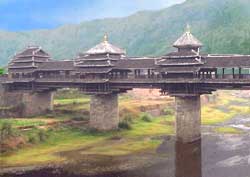Sanjiang Bridges
 Why the
Sanjiang Bridges
are special
Why the
Sanjiang Bridges
are specialThe pagoda topped village bridges in the Sanjiang region have striking architectural designs. The bridge of Chengyang village (see photo) is the most visually stimulating of them all.
Sanjiang Bridges tips and insights
How to pronounce
Sanjiang: san-zhe'ahng
Builders
The bridges of Sanjiang were built by the Dong ethnic people, the largest population group then and now in the Sanjiang region. The Dongs used no nails or other metal fastening devices in constructing their traditional bridges (which demonstrates their architectural and carpentry skills).
Why they were built
Dong riverside villagers need to construct the bridges because they typically reside and work on both banks. You cross the bridge inside its covered corridor. The underlying purpose of the roof is to shelter you from the wind and rain. As a bonus, the roof makes a splendid artistic statement. Because the covered bridges give protection from the wind and rain elements, the Dong people call the structures Wind and Rain bridges.
Materials
Basically, bridge piers are constructed of stone. Pavilions on top of them are made of wood and have flying¸ white trimmed eaves.
Dong villages
When visiting the bridges of Sanjiang, explore the nearby Dong villages to view their fascinating drum towers and water wheels. Almost all Dong villages have a tall, multi-tiered drum tower. It houses a hanging drum that is beaten to alert villagers about emergencies and community meetings. Some drum towers reach higher than a three story building. Many Dong village areas have large, creaking, entrancing water wheels for irrigation.
Nearest major city
The Sanjiang region is a six hour drive from Guilin, the leading tourism city in Guangxi province.


